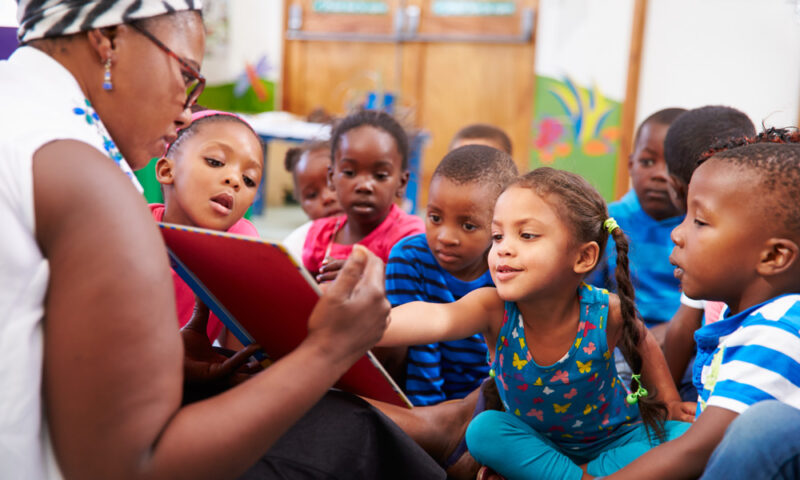Early Childhood
5 Strategies to Integrate Children’s Books into Elementary Math
Humans have listened to and learned from stories for millennia. Every culture has stories to chronicle their origins, explain natural phenomena, teach values, and document important events. Stories help us explain the seemingly unexplainable.
Think about the stories you listened to as a child. I bet that you can recall many of the details of your favorite children’s books, those you read again and again. I loved the Little House on the Prairie series. I learned so much alongside Laura Wilder—about the importance of family, hard work, determination, and lifelong learning. I travelled to the windswept plains of the Midwest, experienced the difficulties of farming, discovered the joy of reading by candlelight (although I used a flashlight), and stood with Laura as she faced her nemesis, Nellie. I also remember Laura learning her times table by rote, which we now know is not the best way for kids to understand the concept of multiplication.
But the right children’s books can help make math meaningful and accessible for all learners. Research shows that incorporating a variety of quality children’s books into your math curriculum allows you to:
- Introduce math concepts in a non-threatening way
- Help students develop a positive attitude toward math
- Increase students’ understanding and use of math vocabulary
- Promote students’ ability to build mathematical connections
- Use visuals to present complex concepts
- Show how math is used in real life
- Integrate math with other subjects
- Increase curiosity and decrease math anxiety
- Provide opportunities for problem solving
- Improve understanding and retention of important mathematical facts and concepts
Given the many rewards of using children’s books in the math classroom, I want to share five strategies that will help you successfully enhance your teaching through quality literature.
1.Choose carefully. I think the following evaluation criteria makes the selection process easier.
Accuracy: Make sure the facts and concepts are presented and labeled correctly and that illustrations elucidate and complement the text. Although in the upper grades, you can use books with inaccurate information and ask students to identify errors.
Visual and Verbal Appeal: For a book to be engaging, it must have a compelling story and interesting illustrations.
Connections: As noted above, children’s books help students make connections between math concepts and show how math is used in the real world. These connections should be authentic and help kids think deeply about mathematical ideas.
Audience: The mathematical concepts should be grade-level appropriate, tied to school/district standards, and further learning objectives. Additionally, material should both reflect students’ lives and interests and expand their horizon, although not always in the same book.
Wow Factor: The books you select need to engage students with new ideas and make them excited to make connections to their own learning and lives.
To get you started, I’m sharing a list of children’s books by math topic.
2.Consider what you want your students to learn and prepare. What mathematical concepts shape the story and how are they presented? What math facts and skills are included? What math vocabulary is used to express ideas and concepts? What are the most likely questions students will pose? What misconceptions might they have? What math problem does the story consider? Knowing how the story enhances your math lesson and what specific skills or concepts are illustrated helps ensure that the story furthers your students’ math learning.
3.Read aloud and encourage discussion. Reading aloud allows all students, even those who struggle with reading, to engage with the story and the math concepts presented. Once you’ve read, and perhaps reread the story, first ask students what they learned. Yes, you want to guide discussion to the mathematical ideas and concepts presented, but I’ve often found that kids make connections that I didn’t consider. Then ask questions to get them thinking and talking about the mathematical concepts presented and how the story relates to what they are learning in class. Stories are a great way for students to experience math in context, so make sure you help them make the link to how math permeates their world.
4.Personalize it. A great way to show students the power of math in their own lives is to have them create personal number stories modeled on the book you’ve read as a class. As students write, draw pictures, or tell stories centered around the mathematical concept(s) explored in the book, they clarify their thinking, deepen their mathematical understanding, see math at work in the real world, and use math language and vocabulary. Writing during math time is also a wonderful way to show kids that math isn’t an isolated subject but connects across the curriculum.
5.Delve into the problems. Create math problems around the math concepts in the book. In many cases, it’s simply a matter of extending the material presented in the story. For instance, a book that discusses the concept of infinity is a great opportunity for students to explore the concept of infinitely small, introducing fractals. Students can cut a sheet of paper in half as many times as possible and determine if they would ever finish. Or think about a story where a character makes a journey. What can kids consider? How many inches, feet, or miles? How many seconds, minutes, or days? What about the arc of the journey—is it a straight line, is it over or under, is there a beginning, middle, and end? What manipulatives—a number line, a Venn diagram, a graph—might enhance mathematical understanding?
Although children’s literature isn’t a substitute for a good math curriculum, it can increase engagement, decrease math anxiety, deepen mathematical understanding, show math at work in kids’ lives, and make learning math even more fun. I’d love to know what books you have used in your classroom!
References
Hellwig, S. J., Monroe, E. E., & Jacobs, J. S. (2000). Making informed choices: Selecting children’s trade books for mathematics instruction. Teaching Children Mathematics, 7(3), 138-143.




